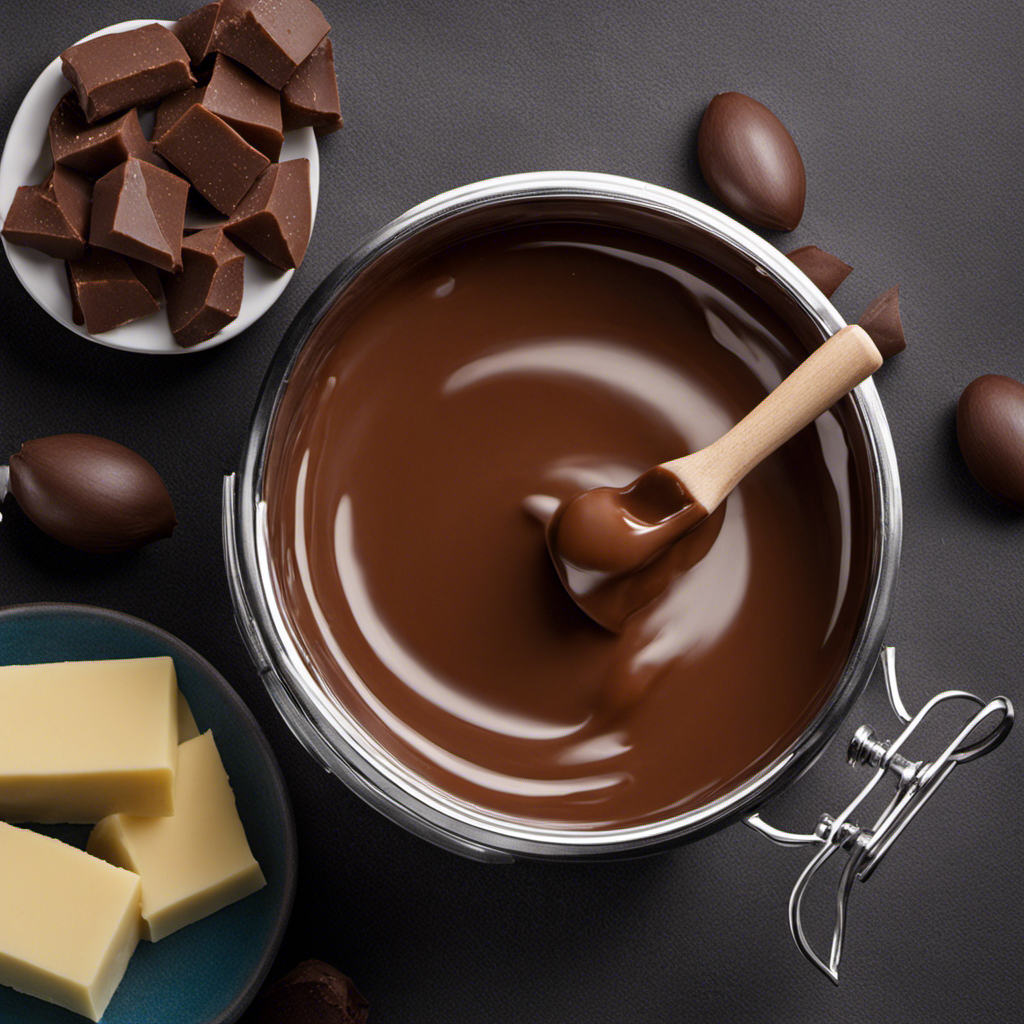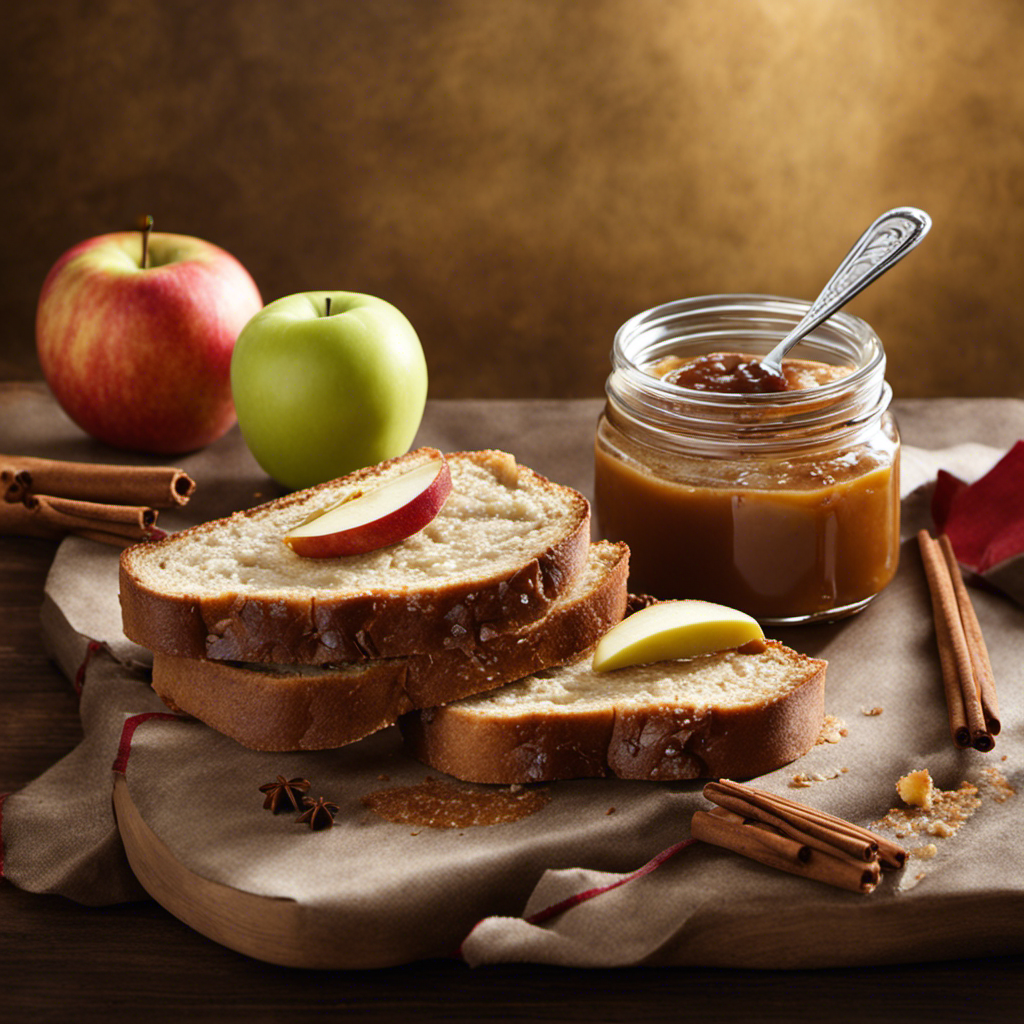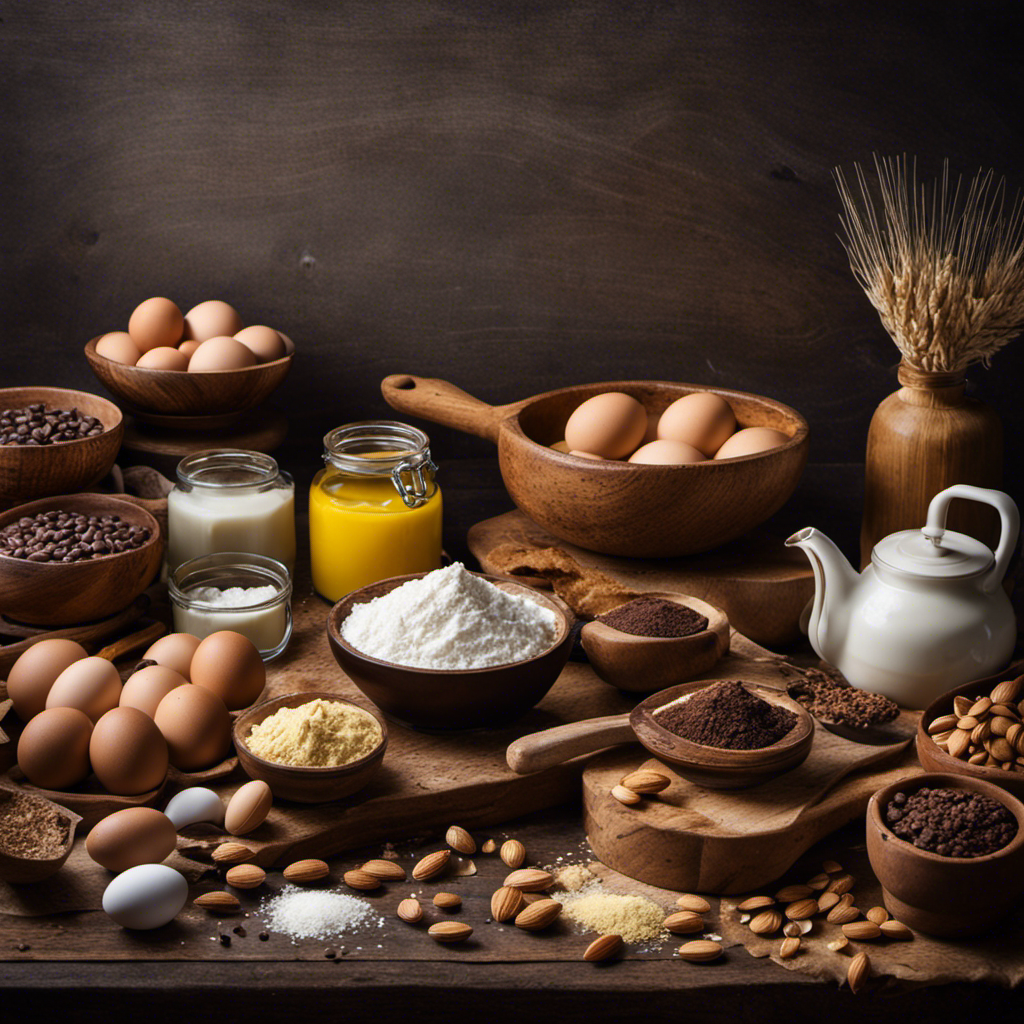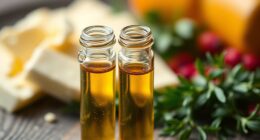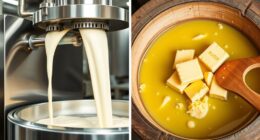I have found the key to getting super soft cocoa butter. This will completely revolutionize the way you work with it. If you’ve experienced the challenge of dealing with solid cocoa butter, you understand the struggle.
But fear not, because I’m here to guide you through the process of softening cocoa butter like a pro. In this article, I’ll explain why it’s crucial, explore different methods, and provide step-by-step instructions on how to soften cocoa butter for all your skincare and culinary needs.
Get ready to unlock the magic of velvety smooth cocoa butter!
Key Takeaways
- Softening cocoa butter allows for easy incorporation into recipes
- Softening ensures seamless mixing with other ingredients
- Different forms of cocoa butter have varying melting points
- Alternative techniques for softening cocoa butter include the microwave method, double boiler method, room temperature method, and food processor method
Why Softening Cocoa Butter Is Important
Softening cocoa butter is important because it allows me to easily incorporate it into my recipes. Cocoa butter, derived from cocoa beans, is a versatile ingredient with numerous benefits. It is rich in antioxidants, which help fight against free radicals and promote healthy skin.
Softening cocoa butter ensures that it mixes seamlessly with other ingredients, resulting in a smooth and velvety texture in baked goods or skincare products. If you don’t have cocoa butter on hand, there are a few substitutes you can use. Shea butter, mango butter, or coconut oil can be used as alternatives, although the flavor and texture may vary slightly.
Softening cocoa butter is crucial in order to fully experience its benefits and create delicious and nourishing treats.
Understanding the Different Forms of Cocoa Butter
Understanding the various forms of cocoa butter can help in achieving the desired consistency in recipes. Cocoa butter is available in different forms, such as blocks, buttons, and powder. The melting temperature of cocoa butter is an important factor to consider when working with it in recipes.
Cocoa butter has a melting temperature between 86 to 95 degrees Fahrenheit (30 to 35 degrees Celsius). It is solid at room temperature but quickly melts when exposed to heat. The different forms of cocoa butter have varying melting points, with buttons and powder having a lower melting temperature compared to blocks.
This knowledge is crucial when softening cocoa butter for use in recipes, as it ensures that the butter melts evenly and contributes to the desired texture and consistency of the final product.
Using Heat to Soften Cocoa Butter
In my experience, using heat is an effective method to soften cocoa butter. Applying heat to cocoa butter helps to break down the solid fat crystals and make it more malleable for various applications.
However, it is important to explore alternative softening techniques to ensure the desired texture and consistency of cocoa butter without compromising its quality.
Heat Method Effectiveness
To soften cocoa butter, you’ll want to try using the heat method and see how effective it is. One popular method is to use a microwave to heat the cocoa butter. Here are some key points to consider when using the microwave method:
-
Use a microwave-safe container: Make sure the container you use is safe to use in the microwave to avoid any accidents or damage.
-
Cut the cocoa butter into small pieces: This will help it melt more evenly and quickly.
-
Heat in short intervals: Start by heating the cocoa butter in 10-second intervals, checking and stirring in between. This will prevent overheating and ensure even melting.
-
Be cautious of overheating: Cocoa butter has a low melting point, so it can easily burn if heated for too long. Avoid heating it for more than 30 seconds at a time.
-
Stir well after heating: Once the cocoa butter has melted, give it a good stir to ensure a smooth consistency.
Alternative Softening Techniques
If you’re looking for different methods to make cocoa butter more pliable, you might want to consider alternative softening techniques. These natural softening methods can help you achieve the desired consistency without the need for excessive heat or chemicals. Here are three effective techniques that you can try:
| Technique | Description | Benefits |
|---|---|---|
| Double Boiler | Place cocoa butter in a heatproof bowl and set it on top of a pot of simmering water. Stir occasionally until melted. Remove from heat and let it cool slightly before using. This method allows for gentle heating, preventing the cocoa butter from becoming too hot and losing its beneficial properties. | Preserves the natural properties of cocoa butter |
| Room Temperature | Soften cocoa butter by simply leaving it at room temperature. Depending on the temperature, this process may take several hours or overnight. The butter will gradually soften, becoming easier to work with. It’s a hands-off method that requires patience but preserves the integrity of the cocoa butter. | Does not require any additional equipment or energy |
| Food Processor | Cut cocoa butter into small chunks and place them in a food processor. Process until the butter reaches the desired consistency. This method works well for larger quantities of cocoa butter and provides a smooth texture. | Allows for easy customization of the cocoa butter’s consistency and texture |
Using Natural Methods to Soften Cocoa Butter
You can soften cocoa butter using natural methods such as warming it gently and blending it with oils. This is a great way to prepare cocoa butter for use in various skincare products. Here are five natural methods to soften cocoa butter:
- Warm and melt the cocoa butter using a double boiler or microwave.
- Mix the melted cocoa butter with carrier oils like almond, coconut, or jojoba oil.
- Whip the mixture using a hand mixer or blender until it becomes creamy and smooth.
- Allow the mixture to cool and solidify at room temperature or in the refrigerator.
- Store the softened cocoa butter in a clean, airtight container for future use.
Using these natural methods, you can easily soften cocoa butter and incorporate it into your favorite skincare products for a nourishing and moisturizing effect.
How to Soften Cocoa Butter for Skincare Products
When it comes to softening cocoa butter for skincare products, understanding its melting temperature is crucial. The melting point of cocoa butter is around 35-37°C (95-99°F), which means it solidifies at room temperature.
However, there are alternative methods available to soften cocoa butter, such as using a double boiler or a microwave, that can make it easier to incorporate into your skincare formulations.
Melting Temperature for Cocoa Butter
To achieve the desired consistency, start by melting cocoa butter at a temperature of around 95 degrees Fahrenheit. This is the optimal temperature for the melting process, as it ensures that the cocoa butter melts evenly and maintains its beneficial properties. Temperature control is crucial during this step to prevent overheating or burning the cocoa butter, which can affect its quality.
Here are some important points to consider:
- Use a double boiler or a microwave-safe container to melt the cocoa butter.
- Stir the cocoa butter continuously to promote even melting and prevent hot spots.
- Keep a close eye on the temperature using a candy thermometer.
- If the cocoa butter exceeds the recommended temperature, remove it from the heat source immediately.
- Allow the melted cocoa butter to cool slightly before using it in your skincare products.
Alternative Softening Methods
Using alternative methods, such as using a warm water bath or a low heat setting on a stovetop, can be effective in achieving the desired softening consistency for cocoa butter. These natural substitutes can provide a DIY solution for those looking to soften cocoa butter without the need for specialized equipment.
When using a warm water bath, simply place the cocoa butter in a heat-resistant container and submerge it in warm water. Allow it to sit for a few minutes until it reaches the desired softness.
Alternatively, using a low heat setting on a stovetop can also soften cocoa butter. Place the cocoa butter in a heat-resistant bowl and heat it gently over low heat, stirring occasionally until it softens.
These DIY recipes offer a convenient and accessible way to achieve the desired consistency for cocoa butter.
Softening Cocoa Butter for Baking and Cooking
Softening cocoa butter for baking and cooking can be achieved by gently heating it on low heat. This process helps to melt the cocoa butter, making it easier to incorporate into recipes. However, there are alternative softening techniques that can be used if you don’t want to heat the cocoa butter. These techniques include:
-
Grating the cocoa butter: By grating the cocoa butter into smaller pieces, it will soften more quickly at room temperature.
-
Using a double boiler: This method involves placing the cocoa butter in a heatproof bowl over a pot of simmering water. The steam from the water gently melts the cocoa butter without direct heat.
-
Microwaving: By using short bursts of low power in the microwave, you can gradually soften the cocoa butter without overheating it.
-
Using a warm water bath: Placing the cocoa butter in a sealed bag and submerging it in warm water will help soften it without direct heat.
-
Softening with other ingredients: Mixing the cocoa butter with softer ingredients like oils or fats can help lower its melting temperature and make it easier to work with.
Storing and Preserving Softened Cocoa Butter
When storing and preserving your softened cocoa butter, it is important to keep it in an airtight container to prevent it from absorbing any unwanted odors or flavors. This helps to prolong its shelf life and maintain its quality. To further ensure the longevity of your cocoa butter, consider the following storing techniques:
| Technique | Description |
|---|---|
| Temperature | Store cocoa butter in a cool, dry place with a temperature between 60-70°F (15-21°C). Avoid exposure to direct sunlight or excessive heat. |
| Packaging | Use airtight containers made of glass or food-grade plastic. This prevents air and moisture from entering and causing rancidity. |
| Labeling | Clearly label the container with the date of purchase or expiration to keep track of its freshness and usage. |
Frequently Asked Questions
Can I Use a Microwave to Soften Cocoa Butter?
Yes, you can use a microwave to soften cocoa butter. It is a quick and convenient method. However, some experts prefer the stovetop method as it allows for better temperature control.
Can I Use a Hairdryer to Soften Cocoa Butter?
Using alternative methods to soften cocoa butter, a hairdryer can be effective. Pros include quick results and easy control of temperature. However, cons include potential overheating and uneven melting. Ensure caution and proper temperature regulation.
Can I Add Water to Soften Cocoa Butter?
Adding water is not recommended for softening cocoa butter as it can alter its texture and affect its performance. Instead, using heat through methods like a double boiler or microwave can effectively soften cocoa butter.
Can I Use a Double Boiler to Soften Cocoa Butter?
Using a double boiler to soften cocoa butter has its pros and cons. It provides gentle heat and prevents burning, but it may take longer. Other methods, like using a microwave, are faster but can easily overheat the butter.
Can I Soften Cocoa Butter Using a Blender or Food Processor?
Using heat to soften cocoa butter is a common method, but alternatives to using a blender or food processor exist. I found success by gently heating cocoa butter in a double boiler.
Conclusion
In conclusion, softening cocoa butter is a crucial step in various applications. Whether it’s for skincare products or baking and cooking, understanding the different forms of cocoa butter and utilizing heat or natural methods is key. By doing so, you can achieve the desired consistency.
Remember to store and preserve your softened cocoa butter properly to maintain its quality. This is important for both skincare enthusiasts and aspiring chefs.
Mastering the art of softening cocoa butter will elevate your creations to a whole new level of decadence and indulgence. So whether you’re passionate about skincare or cooking, it’s worth learning how to soften cocoa butter effectively.
